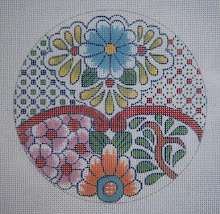 This pink shape certainly looks like one of the pond scum critters I used to study under the microscope in college, except for the color. My prof always said I had the prettiest journal in the class, as we had to draw what we saw for record keeping. (I did stick to the pen and ink, with no color.)
This pink shape certainly looks like one of the pond scum critters I used to study under the microscope in college, except for the color. My prof always said I had the prettiest journal in the class, as we had to draw what we saw for record keeping. (I did stick to the pen and ink, with no color.)Anyway, the shape was devised to illustrate the places people seem to have trouble with.
It might seem strange to go to so much trouble for just the seam allowance/background of an ornament, but forming good habits makes it easier to stitch effectively and produce smooth, nice surfaces in your projects. It actually becomes second nature, once you've learned properly. Also, I see people going to great trouble to make sure of a nice surface on their work - like separating the plies of silk and putting them back together, and using laying tools and frames - so it only makes sense to form the habit of stitching proper basketweave also, as this is a contributing factor.
The lower arrow shows the last stitch on that row before having to start at the upper curve, as it's actually on a warp row - only 3 stitches, but this continuity is important.
Then the stitching is continued until you hit the dark outline.
 The arrow points to this place, and you can see by enlarging the picture that it is a weft row.
The arrow points to this place, and you can see by enlarging the picture that it is a weft row.
The next picture simply shows the stitches continuing in order around the shape. NEVER turn the canvas upside down and begin stitching the little "V" shape - it will leave an ugly place in the work either as a groove or a ridge where it meets the stitches already done. This is a very bad habit, even for a small piece.

The V is filled in here - and the upper arrow on the left shows where the last stitch in the background is made on this row, as it meets the outline. The lower arrow demonstrates that there is a short row just above this that has to be dealt with before going back up on the log weft row.
 In the interest of time, I won't show this completed - it is only an exercise for demonstration. Just continue around the shape, and again where the arrows are, consider where to stop and start for continuity of stitching. The right side continues all the way around the curves, and the arrow on the bottom shows the first stitch that will join the two sides - a weft row.
In the interest of time, I won't show this completed - it is only an exercise for demonstration. Just continue around the shape, and again where the arrows are, consider where to stop and start for continuity of stitching. The right side continues all the way around the curves, and the arrow on the bottom shows the first stitch that will join the two sides - a weft row.  I found this picture in a file of a piece I stitched that Tish Watkins painted - used it as a beginner exercise in an article in NN last year. It clearly shows the rose sections outlined before the decorative stitches were made, and the edges are very neat and defined. Also no confusion or ragged edges against the background, which is rather busy!
I found this picture in a file of a piece I stitched that Tish Watkins painted - used it as a beginner exercise in an article in NN last year. It clearly shows the rose sections outlined before the decorative stitches were made, and the edges are very neat and defined. Also no confusion or ragged edges against the background, which is rather busy!
2 comments:
Okay, I'm guilty. I do sometimes turn it upside down to make it easier for me to stitch. Will be a good girl from now on. Thanks for teaching me the correct way to do this. I'll be a better stitcher now. LOL
Hello
I am from Greece
I worship blog your I love Craft
See my New blog for crafts
blog http://potpouri-art.blogspot.com/
Thanks for your time
Post a Comment